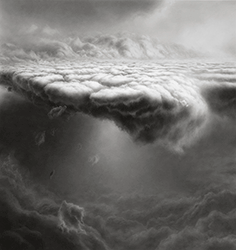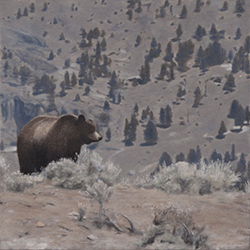January 8- February 19, 2022
Reception: January 8, 2022 4-6 pm
In her essay for Hilary Brace’s exhibition, Rachel McCullah Wainwright, Curator at the Bakersfield Museum of Art, describes one’s initial encounter with Brace’s charcoal drawings as “an immediate polarity” and a reckoning with “process and imagery." This is because they are at once intimate and sublime. They are realistic depictions of clouds and weather, yet fantastically on the edge of believability. And her technique is so extraordinary that one’s first inclination is to guess they are photographs, though that assumption becomes unsettling when the epic and mythical proportions of these subjects sinks in. Reviewing the work for the New York Times, Ken Johnson declared, “Once in a while you come across an art of such refined technique that it seems the product of sorcery more than human craft.” Starting with the smooth surface of polyester film darkened with charcoal, Brace works in a reductive manner by removing charcoal with erasers and other handmade tools. As Wainwright concludes, “In a world saturated with images and information, these works slow us down, encourage wonder and confirm the importance of observing, exploring and reconsidering, for things are often not what they seem.” In this, and her previous exhibition at Craig Krull Gallery, Brace has taken this sorcery to further spectacular heights by translating her wildly Baroque weather phenomena into large-scale textiles at the TextielLab in Tilburg, The Netherlands. Working with a sophisticated Jacquard loom and unusual combinations of reflective and luminescent threads, Brace achieves what she calls, “a light reactive surface…so that the pieces change in response to the light source or the position of the viewer; alive, like light in nature.”
Pamela Kendall Schiffer’s reverential approach to landscape painting parallels the work of the Tonalist painters of the early 20th Century who avoided majestic spectacle in favor of a more reductivist composition and subdued palette that evoked a poetic mood. For her exhibition at Craig Krull Gallery she wrote;
"My ongoing paintings of Yellowstone National Park continue with a new series that started over six years ago. The Yellowstone wilderness is a part of my greater backyard, only a 45-minute drive south of my home in Montana. The quiet, intimate scale of these paintings suggests a sense of the sacred beauty to be found in the Park. The paintings capture a simple fleeting moment, and at the same time, the grand eternal present. Some are a haiku (a spouting geyser, a waning moon, two trees in snow, a night sky, the smudges of a few clouds, the serenity of day’s end). Others are more complex considerations, as with First Light, Lower Yellowstone Falls, its canyon walls being impossibly vertical and powerful—containing elements of granite, water, steep erosion, time, light vs dark shadow, sensuous imagery—a geologic layering of ideas within a 12” square surface. After the extinction of the California Grizzly, the remaining presence of grizzly in Yellowstone is all the more precious and spotting them in the wild is always spine-tingling. Paintings of a coyote’s intense gaze, or the elegant curves of a sandhill crane convey such simple grace, they remind me of Frederick Sommer’s observation, “A straight line in the right place can bring you to tears.”

